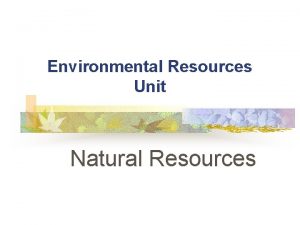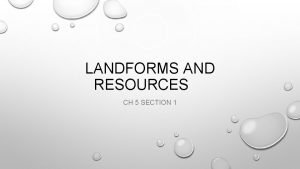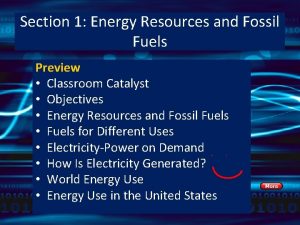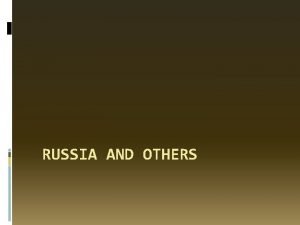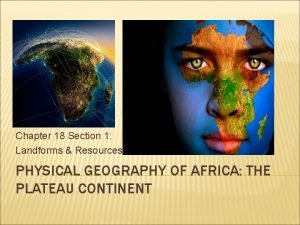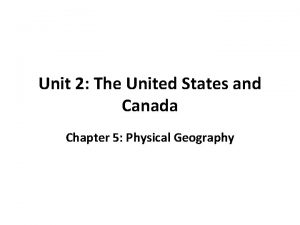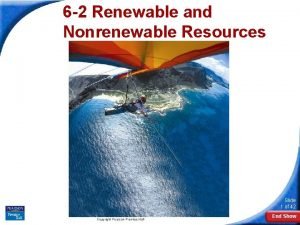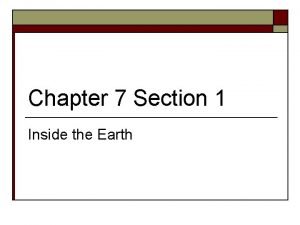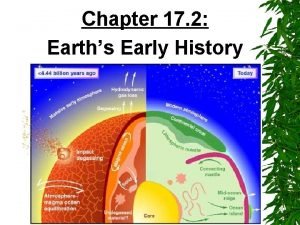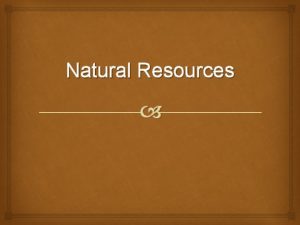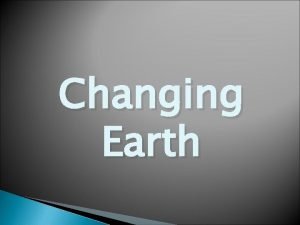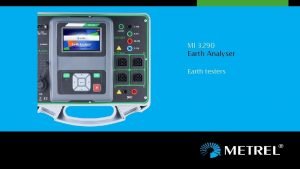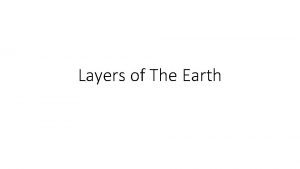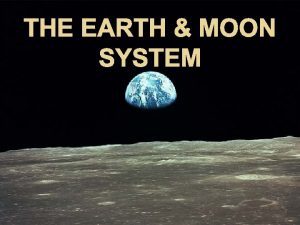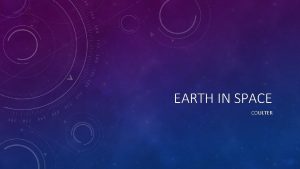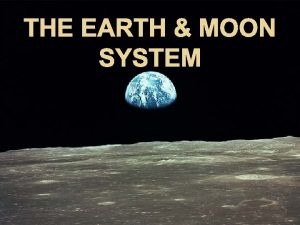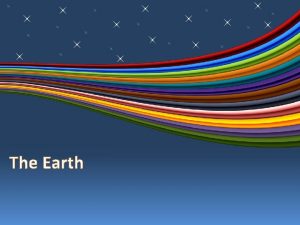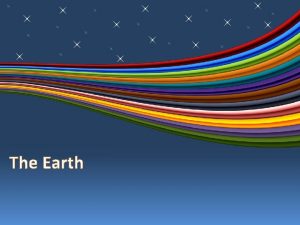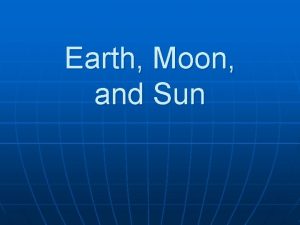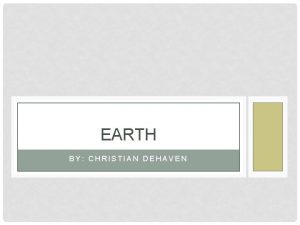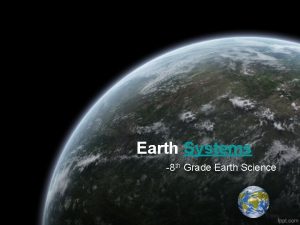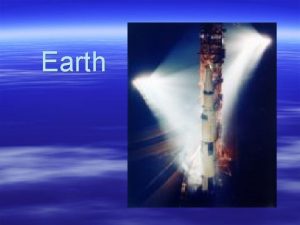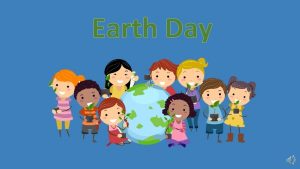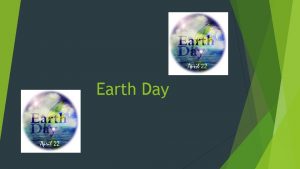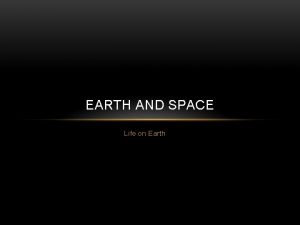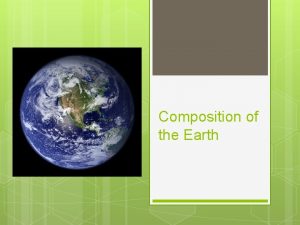Earth Resources Section 1 Section 2 Section 3






















- Slides: 22

Earth Resources Section 1: Section 2: Section 3: Section 4: Natural Resources from Earth’s Crust Air Resources Water Resources

• Section 1: Resources are materials that organisms need; once used, some resources can be replaced, whereas others cannot. • Section 2: Earth’s crust provides a wide variety of resources to grow food, supply building materials, and provide metals and minerals. • Section 3: The atmosphere contains gases required for life on Earth. • Section 4: Water is essential for all life, yet it is unevenly distributed on Earth’s surface.

Section 1 – Natural Resources • Essential Questions: – What are renewable and nonrenewable resources? – What is a sustainable yield? – How are resources unevenly distributed on Earth?

• Every living thing on Earth must have certain resources to grow, develop, maintain life processes, and reproduce. • Natural resources are resources that Earth provides. • Natural resources include Earth’s organisms, nutrients, rocks, water, and minerals. • Natural resources come from the soil, air, water, or deep in Earth’s crust.

• Renewable resources are resources that can be replaced by nature in a short period of time. • Renewable resources include fresh air, fresh surface water, and most groundwater. • Renewable resources include all living things and elements that cycle through Earth’s systems.

• Sustainable yield is the replacement of resources at the same rate at which it is being consumed. • The Sun provides an inexhaustible source of energy for all processes on Earth.

• Nonrenewable resources are resources that exists in a fixed amount and can only be replaced in millions of years. • Fossil fuels, diamonds, gold, copper, and silver are considered nonrenewable resources.

• Natural resources are not evenly distributed on Earth. • Some areas have natural resources while others may not. • People in the US make up about 5% of the world’s population but consume about 25% of Earth’s resources.

Section 2 – Resources from Earth’s Crust • Essential Questions: – Which materials from Earth’s crust are considered natural resources? – Why is the need to protect Earth’s land surface as a resource important? – How is the uneven distribution of resources worldwide explained?

• Land resources include sand, mulch, peat moss, topsoil, and rocks. • Land also provides places for growth of crops, forests, grasslands, and wilderness areas. • Many areas within the US are publicly managed. • These areas are protected from development and will remain in their natural state.

Section 3 – Air Resources • Essential Questions: – How is the atmosphere a resource? – How are the carbon and nitrogen cycles illustrated? – What are natural sources of air pollution?

• Most organisms require oxygen. • Earth’s atmosphere did not always contain oxygen. • Early life forms used carbon dioxide during photosynthesis and released oxygen. • Over time enough oxygen developed in the atmosphere for other organisms to form.

• The Law of Conservation of Mass states that matter on Earth never changes. • It cannot be created nor destroyed. • Elements move through various cycles.

• Carbon is a key element in living things. • Organisms release carbon dioxide into the atmosphere. • Carbon is stored in organisms buried under the ground. • Carbon dioxide is released when fossil fuels are burned.

• Nitrogen is needed by organisms to produce proteins. • Nitrogen makes up 78% of Earth’s atmosphere. • Nitrogen moves from the atmosphere to the soil, to living organisms, and then back to the atmosphere.

Natural Air Pollution Sources • Pollutant is a substance that enters Earth’s geochemical cycles and can harm the wellbeing of living things or adversely affect their activities. • Volcanoes can produce ash and sulfur dioxide. • Fires can produce carbon monoxide, smoke, and fine particles. • Radon is a radioactive gas that can be released from the ground and cause lung cancer.

Section 4 – Water Resources • Essential Questions: – Why are the properties of water important for life on Earth? – How is water distributed and used on Earth? – In what ways can humans reduce the need for freshwater resources?

• About 71% of Earth’s surface it covered by water. • Freshwater in an important resource for agriculture, transportation, recreation, and numerous other human activities. • Most animals are about 50 -65% water.

Water is versatile. It has a high boiling point of 100°C. Water has a low freezing point of 0°C. Water can exist in the liquid form over a variety of environments. • Water takes a lot of energy to heat up but once it is warm it stays warm a long time. • Solid ice has a lower density than liquid water and it floats. • •

• Unlike most liquids, water expands when it freezes. • Because it has a lower density, it floats on top of liquid water. • If this did not happen bodies of water would freeze solid each winter causing water organisms to die.

• Freshwater resources distribution is a continuing problem worldwide. • Scarcity of water results in the death of 24, 000 people each year. • Overuse of groundwater can cause drawdown (water table is lowered) can cause wells to run dry.

• Desalination is the process of removing salt from seawater. • Desalination plants use heat to distill saltwater and produce freshwater.
 The transformation process
The transformation process Fixed and variable resources examples
Fixed and variable resources examples Renewable vs nonrenewable resources worksheet
Renewable vs nonrenewable resources worksheet Chapter 27 human impact on earth resources
Chapter 27 human impact on earth resources Earth resources examples
Earth resources examples How do people destroy natural resources
How do people destroy natural resources Earth resources examples
Earth resources examples Earth resources kitty hawk
Earth resources kitty hawk Chapter 24 section 1 landforms and resources
Chapter 24 section 1 landforms and resources Landform in asia
Landform in asia Chapter 5 section 1 landforms and resources
Chapter 5 section 1 landforms and resources Chapter 27 physical geography of east asia
Chapter 27 physical geography of east asia Chapter 11 section 1: water resources answers
Chapter 11 section 1: water resources answers Fossil fuel deposits
Fossil fuel deposits Landforms and resources section 1
Landforms and resources section 1 Chapter 18 section 1 landforms and resources
Chapter 18 section 1 landforms and resources Unit 2 the united states and canada worksheet answers
Unit 2 the united states and canada worksheet answers 6-2 renewable and nonrenewable resources
6-2 renewable and nonrenewable resources Section 17-2 earth's early history answer key
Section 17-2 earth's early history answer key In what section of earth do earthquakes happen?
In what section of earth do earthquakes happen? Chapter 7 section 1 inside the earth answer key
Chapter 7 section 1 inside the earth answer key Chapter 7 section 1 inside the earth answer key
Chapter 7 section 1 inside the earth answer key Section 17-2 earth's early history
Section 17-2 earth's early history





